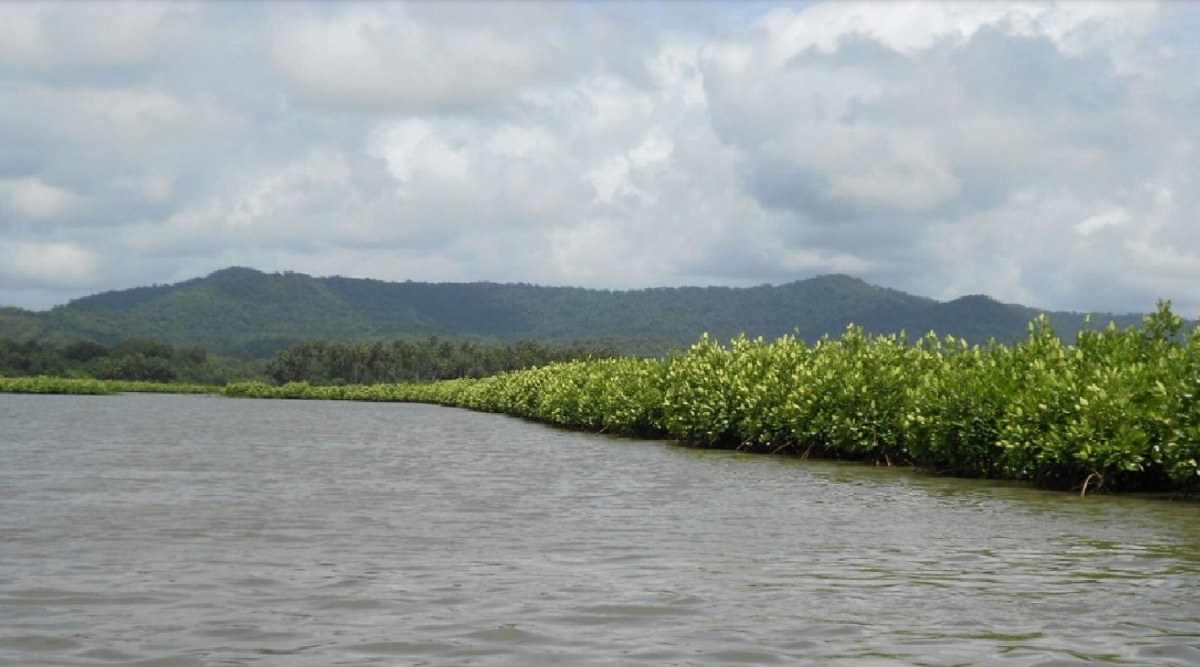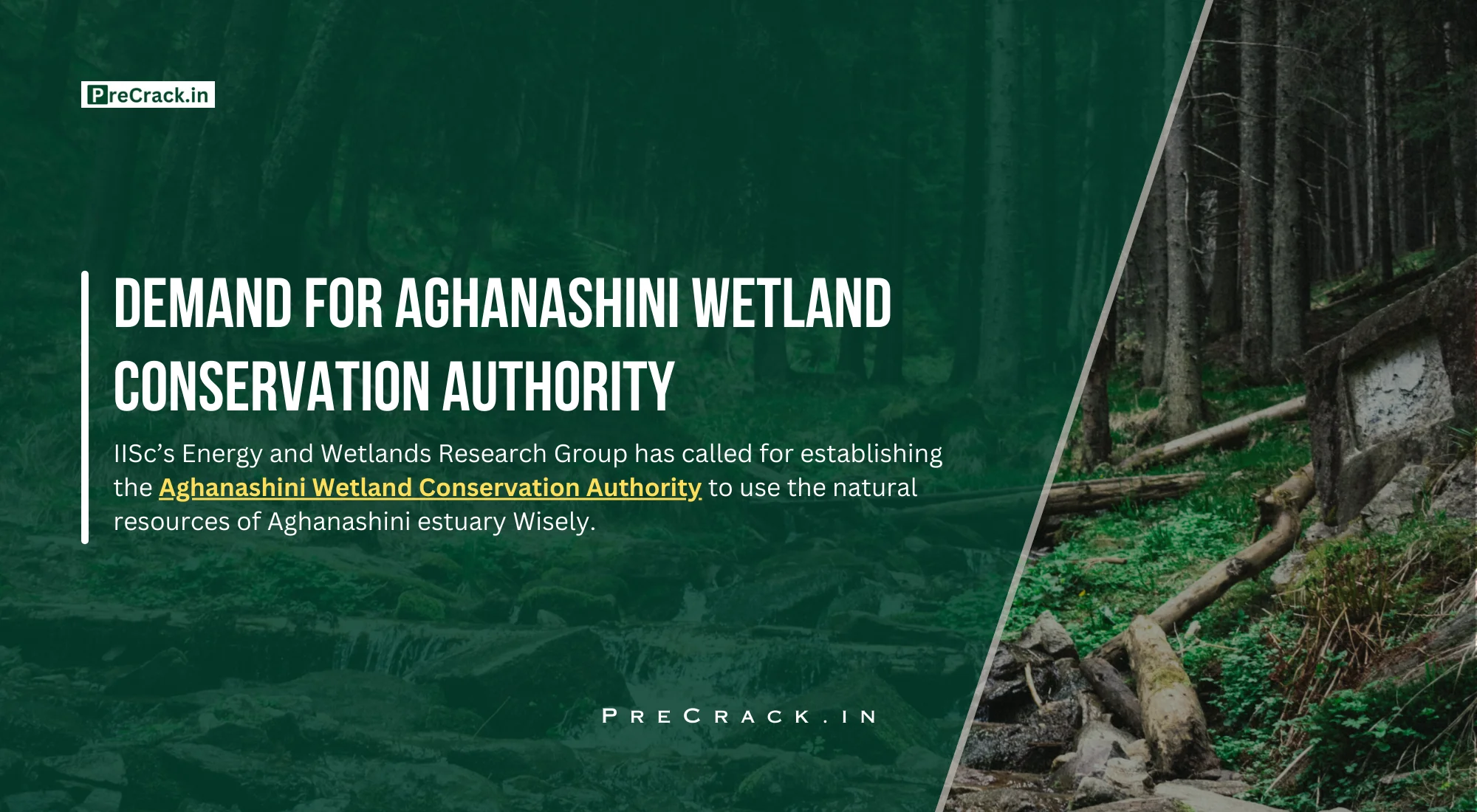Welcome to PreCrack! We’re here to provide you Information about all best topics in their simplest manner that may help you to Crack UPSC CS Prelims Exam.
Naresh Soni
Demand for Aghanashini Wetland Conservation Authority by EWRG – PreCrack.in
Table of Contents
Introduction to Aghanashini Wetland Conservation Authority
Welcome to PreCrack! Recently, there was a raise of demand for Aghanashini Wetland Conservation Authority by EWRG (Energy & Wetland Research Group). Knowing about this development will help you to understand the need of the conservation of one of the Ramsar site in Aghanashini Estuary.
Also, if you are preparing for major competitive examinations in India such as UPSC, SSc or more then, knowing about this development will help you to cover your UPSC Current Affairs Portion. If you are also willing to know about this development then read this blog to the end.
So, let’s start –

Read Also | New Discovery! ‘Indopria’, A New Species of Parasitoid Wasp Discovered!
Why is Aghanashini Wetland Conservation Authority in the news?
The Aghanashini Wetland Conservation Authority has garnered attention due to its proposed establishment for the sustainable management of the Aghanashini estuary. This authority aims to address conservation concerns related to this Wetland and foster collaboration among stakeholders and communities.
With the estuary recently designated as a Ramsar site, the need for effective management strategies to preserve its biodiversity, mangroves, fisheries, and mitigate climate change impacts has become increasingly urgent.
Source – The Hindu
What is Aghanashini Wetland Conservation Authority?
The Aghanashini Wetland Conservation Authority is like a team set up to take care of the Aghanashini estuary. Its job is to make sure the estuary and its surroundings are looked after properly.

This means they’ll work on things like protecting the animals and plants living there, keeping the water clean, and making sure people use the area in a way that doesn’t harm it. The authority will include different people and groups, like scientists, government officials, and local communities, who will all work together to make decisions and plans for how to best take care of the estuary.
They’ll come up with rules and strategies to ensure that the estuary stays healthy and that everyone can continue to benefit from its resources while also protecting it for the future.
About Aghanashini Estuary
The Aghanashini Estuary, located in Kumta taluk of Uttara Kannada district, is a vital ecosystem where the Aghanashini river meets the Arabian Sea.

Spanning 4,801 hectares, it recently gained recognition as one of the five wetlands designated as Ramsar sites under the Ramsar Convention.

This estuarine ecosystem supports a rich diversity of flora and fauna, including over 80 fish species, 115 bird species, and 45 mangrove species. It sustains the livelihoods of thousands of families and plays a crucial role in carbon sequestration, contributing to climate change mitigation efforts.
Its Need / Objective of Conservation Authority
The call for establishing an Aghanashini Wetland Conservation Authority likely focuses on the following objectives:
1. Preserving the Ecological Balance
The Aghanashini estuary is a rich ecosystem known for its diverse flora and fauna. Establishing a dedicated authority would enable the implementation of conservation plans to protect the wetlands and the species it supports.
2. Sustainable Management
The proposed authority could promote practices that ensure the long-term health of the estuary. This might involve regulating activities like fishing and pollution to minimize their ecological impact.
3. Balancing Livelihoods and Conservation
The wetlands support the livelihoods of several local communities. The authority could introduce measures that balance conservation efforts with the economic needs of people dependent on the ecosystem, potentially through promoting sustainable fishing practices and alternative income sources.
4. Research and Monitoring
A dedicated body could facilitate research initiatives to gain a deeper understanding of the wetland’s ecology and implement data-driven conservation strategies.
Components of Aghanashini Wetland Conservation Authority
The proposed Aghanashini Wetland Conservation Authority, here are some possible components:
1. Governing Body
A board comprising representatives from various stakeholders:
- Local communities dependent on the wetland for their livelihood.
- Environmental experts and scientists with knowledge of the Aghanashini ecosystem.
- Government officials responsible for environmental protection and local development.
2. Scientific Advisory Panel
A team of experts providing scientific guidance on ecological matters, including:
- Wetland ecologists specializing in the Aghanashini estuary.
- Researchers with experience in sustainable resource management.
- Fisheries specialists to advise on regulating fishing practices.
3. Management Staff
Professionals responsible for implementing the authority’s policies and initiatives:
- Wetland managers with expertise in overseeing conservation efforts.
- Researchers to monitor the ecological health of the wetlands.
- Outreach and education specialists to raise public awareness.
4. Law Enforcement
A designated unit to ensure adherence to regulations established by the authority:
- Environmental officers to patrol the protected area.
- Law enforcement personnel to address violations of conservation laws.
5. Funding Mechanism
A sustainable source of funding to support the authority’s activities:
- Government grants allocated for wetland conservation.
- Partnerships with private organizations or NGOs involved in environmental projects.
- Potential for fees associated with responsible eco-tourism activities.
6. Research and Monitoring Department
A dedicated team for:
- Conducting research on the wetland’s ecology to understand its environmental status.
- Monitoring water quality, flora and fauna populations.
- Analyzing data to inform conservation strategies.
Key Stakeholders
Key stakeholders for the proposed Aghanashini Wetland Conservation Authority include:
- Local Communities: Those living near or dependent on the Aghanashini estuary for their livelihoods.
- Government Agencies: Authorities responsible for environmental regulation and management at local, regional, and national levels.
- Conservation Organizations: NGOs and environmental groups actively involved in wetland conservation efforts.
- Academic Institutions: Researchers and scholars providing scientific expertise and knowledge to inform conservation policies and practices.
- Community Leaders: Representatives from local community organizations and leadership structures.
- Businesses and Industries: Entities with economic interests in the estuary, such as fisheries, tourism, and agriculture.
- Indigenous Groups: Indigenous communities with cultural ties to the estuarine ecosystem.
- Tourism Operators: Businesses involved in promoting and managing tourism activities in the region.
- Experts and Consultants: Professionals providing specialized advice and guidance on wetland conservation and management.
- Government Officials: Elected representatives and appointed officials involved in decision-making processes related to the establishment and operation of the conservation authority.
FAQs – Aghanashini Wetland Conservation Authority UPSC Questions
Question-1: What is Aghanashini Wetland Conservation Authority?
Answer. The Aghanashini Wetland Conservation Authority is a proposed body aimed at overseeing the sustainable management of the Aghanashini estuary’s natural resources.
Question-2: Why establish Aghanashini Wetland Conservation Authority?
Answer. It aims to ensure the wise use of resources in the estuary, addressing conservation challenges and fostering collaboration among stakeholders.
Question-3: What are key features of Aghanashini estuary?
Answer. The estuary spans 4,801 hectares and is home to diverse flora and fauna, including numerous fish, bird, and mangrove species.
Question-4: How large is Aghanashini estuary?
Answer. Covering an area of 4,801 hectares, it serves as a significant ecological hotspot.
Question-5: Which species inhabit Aghanashini estuary?
Answer. More than 80 fish, 115 bird, and 45 mangrove species reside within the estuary’s ecosystem.
Question-6: Is Aghanashini estuary a Ramsar site?
Answer. Yes, the Aghanashini estuary is among the five wetlands recently designated as Ramsar sites under the Ramsar Convention.
Question-7: Who advocates for Aghanashini Wetland Conservation Authority?
Answer. Conservationists, including the IISc.’s Energy and Wetlands Research Group, are leading the call for its establishment.
Question-8: What role does IISc’s Energy and Wetlands Research Group play?
Answer. They provide expertise and support for conservation efforts and are actively involved in advocating for the establishment of the authority.
Question-9: What benefits does Aghanashini Wetland Conservation Authority offer?
Answer. It promises sustainable resource management, protection of biodiversity, and mitigation of climate change impacts.
Question-10: Which organizations participate in conservation efforts?
Answer. Besides the IISc.’s Energy and Wetlands Research Group, organizations like the Panchabhuta Conservation Foundation and others collaborate in these efforts.



